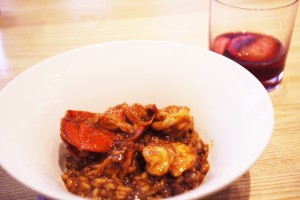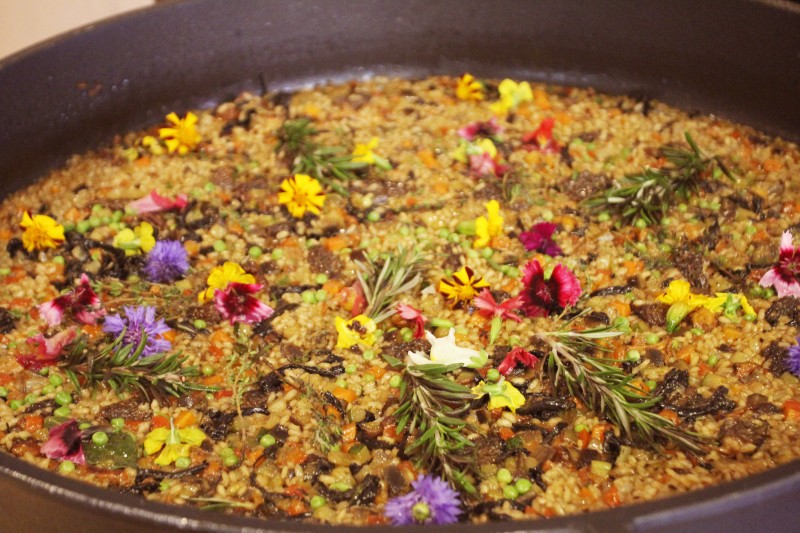July is Paella Party Season
/By Christina Brown, special to Edible DC Don't let the summer heat fool you. July is a perfect time to sample some of the city's interpretations of this famous Spanish dish! Do you have leftovers from your July 4th BBQ? They might be a perfect addition to your paella pan.. Just take it from Chef Quim Marqués, a childhood friend of Chef José Andrés and this year's guest chef for the 2015 Annual Paella Festival, which will be held from July 13 to July 26 at all three local Jaleo locations. Chef Marqués’ barbeque paella was inspired from time the chef spent in Texas, and he is sourcing the bellota sausage and pork ribs from local farms.
Or, for a more classic take on Spanish paella, look no further than the caldero de arroz flamenco, a soupy seafood version of the dish that includes clams, cockles, cuttlefish, and head-on shrimp. It’s not bad with a side of red or white sangria, either!
For our vegetarian or vegan friends, you can create the delectable and intensely flavorful paella de verdura, or vegetable paella, using the recipe below. And if you'd like to channel your true inner Spaniard, you can shop alongside Jaleo Executive Chef Ramón Martínez at the FRESHFARM's Penn Quarter market on Thursday afternoons, where he purchases fresh local vegetables used in this dish such as chanterelle mushrooms. He adjusts the recipe according to what is freshest that day, so don't hesitate to experiment yourself!
The perfect way to finish your Spanish feast is with Jaleo’s helado de aceite de olive con pomelo, which places a delicious and savory olive oil ice cream above chilled, tangy, grapefruit texturas.
Paella de Verduras
Vegetable Paella
Serves 4 to 6
For the alioli:
Makes 1 cup
1 small egg
1 cup Spanish extra virgin olive oil
1 clove garlic, peeled
1 teaspoon sherry vinegar or fresh lemon juice
Sea salt, to taste
Add the egg, 2 tablespoons of the olive oil, the garlic clove, and the vinegar or lemon juice to the bowl of a food processor fitted with a steel blade.
Process the ingredients at high speed until the garlic is fully puréed and the mixture becomes a loose paste. While processing, slowly begin to add the remaining olive oil drop by drop. If the mixture appears too thick, add 1 teaspoon of water to loosen the sauce. Continue adding the oil and the sauce becomes rich and creamy and light yellow in color. Season with salt, to taste.
For the sofrito:
Makes 3 cups
10 ripe plum tomatoes, sliced in half
1 ½ cups Spanish extra-virgin olive oil
4 small Spanish onions, finely chopped
1 teaspoon sugar
1 teaspoon salt
1 teaspoon pimentón, or Spanish smoked paprika
3 bay leaves
Place a grater over a mixing bowl and grate the open side of the tomatoes down to their skins. Discard the skins.
Heat the oil in a medium saucepan over medium-low heat. Add the onions, sugar, and salt. Cook, stirring occasionally, until the onions are soft and golden brown, or caramelized, about 45 minutes. Add a ½ teaspoon of water to the onions if they begin to burn.
Stir in the tomato purée, the pimentón, and the bay leaves and cook over medium heat until the tomatoes have broken down and deepened in color, and the oil has separated from the sauce, about 20 minutes. Discard the bay leaves and store the sauce in the refrigerator, covered, until ready to use.
For the paella:
¼ cup Spanish extra-virgin olive oil
1 bunch spring onions, thinly sliced
1 bunch asparagus, trimmed and cut into 2-inch pieces
3 cups spinach
1 teaspoon minced garlic
2 ripe plum tomatoes, diced
¼ cup sofrito
1 cup dry white wine
Pinch of saffron
3 cups flat mineral or filtered water
1 cup Spanish Bomba or Calasparra rice
Sea salt, to taste
Fresh thyme sprigs, for garnish
Alioli, for serving
Heat the olive oil in a 13-inch paella pan over medium-high heat. Add the onions and sauté until soft and lightly browned, about 3 minutes. Add the asparagus and garlic and cook for 2 minutes more. Stir in the plum tomatoes and the sofrito and cook for 1 minute. Pour in the white wine and let it reduce by ½, about 2 minutes.
Crumble the saffron into the pan and pour in the mineral water. Increase the heat to high and bring the mixture to a boil. Let the mixture boil for 2-3 minutes, then add the rice and peas and stir until well combined. Reduce the heat to medium-high, season with salt, to taste, and cook for 4 minutes. Do not stir the rice again, as this can cause it to cook unevenly.
After 4 minutes, reduce the heat to low and cook for another 7 minutes. Remove the paella from the heat, cover with a clean kitchen towel, and let rest for 5 minutes. Garnish with fresh thyme sprigs and serve with the alioli.
About the author: When she is not exploring or photographing the city, Christina Brown is the marketing manager at The SEED Foundation, which oversees the SEED network of public, charter boarding schools. She is currently on a mission to find barbecue that can satisfy the craving she brought with her from Memphis, TN.





